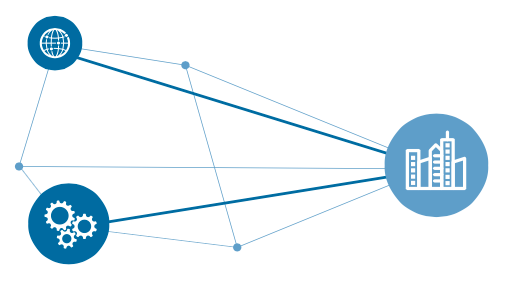
Read more of Prospect's "Data as infrastructure" report What could data do for planning? In towns, cities and the countryside, citizens could interact with data driven models during the consultation process. These models could let residents “see” new developments before they are completed and their reaction could inform the decision-making of governments and local authorities.
It sounds like a great idea and if organised, could improve our slow and cumbersome processes of decision-making. However a world of instant responses is not without its limitations. As Jane Jacobs pointed out in her iconic book The Death and Life of Great American Cities, people make cities and not buildings. Cities are incredibly complex organisms and any successful model of a city needs to reflect the diversity and needs of the people who live there.
In Manchester and other cities 30 years ago, there were often large wooden block models of the city centre on public display. The idea of this model was to test the impact of new buildings. The model no longer exists, not because it wasn’t a useful tool, but because the city could not afford to employ the people who maintained the model. The world today contains a far greater range of constraints and policies than can be contained in a wooden model. A constant stream of consultations and digital models for citizens to appraise would not come cheap.
Even so, public consultation is enshrined in the UK planning process. There is an established system: planning applications and most consultation responses are made online and all applications are reviewed against a series of planning and environmental policies. The UK is covered by a system known as the Geographic Information System, which can be accessed by central and local government and contains data on all aspects of public and private land. It also contains a range of critical factors against which planning applications will be judged, such as whether land is designated as green belt, whether it contains listed buildings, is at risk of flood and so on. Planning applications are also subject to the National Planning Policy Framework, Local Authority plans, Local Area Plans and housing allocation plans.
“Documents for planning applications can be 30Mb each and individuals sometimes need to download dozens to get the full picture”The process is a complex one, but the incentive to get it right is enormous. Planning submissions are driven by the need for economic development, more housing and by the desire to create employment opportunities. Towns and cities without new growth or economic development face very severe challenges.
The planning process is helped if the architectural quality of the project is high—the look of the new construction is often a key issue in the debate. It is right that the public should have a say on this, along with the density and type of development. However, planning applications are assessed not just on their visual impact but on their overall environmental impact; an issue that brings with it a swathe of complex environmental legislation. Local residents are often concerned about the impact on views, traffic and the pressure put on schools by new developments. In a data driven planning landscape all of these potential effects must be codified and recorded in a consistent way.
With this in mind, there are a number of commercial virtual 3D models of cities in the UK which are of increasing interest to planners. However, in order for this type of model to become useful in the planning process, the constraints need to be addressed. There are also important questions such as: who is going to pay for the development of the computer model, which organisation holds the model data and what are the access arrangements?
The government is under pressure from developers to create a simpler, quicker and cheaper planning process. Pushing in the other direction, the public is demanding more information and greater transparency in the process. There is no simple answer here.
If the future of planning consultation is that residents will examine a 3D model of a proposed development, then that model itself needs to be in an accessible format. At the moment, documents for individual planning applications can be 30 megabytes each and individuals can sometimes need to download dozens of plans and documents to understand the full scope of a scheme. Downloading that amount of data can put a conventional computer under strain. The models of a whole city will contain terabytes of data, an amount far beyond the capacity of a home computer.
The largest technology companies are looking at the collation and dispersal of huge amounts of information—and that costs money. However there is no immediate funding for local planning authorities to pay for and develop the platforms and processes necessary to make any of this work. The idea of data led planning will remain as relevant as the old wooden block model of the city unless solutions to these issues are developed.
On the 3rd of October, Prospect launched Data as Infrastructure. This special report grew out of a series of high-level roundtable meetings over the summer which brought together government, private businesses and the third sector to look at how data is already being used to improve people’s lives and how it has the potential to do so much more.
To find out more about how you can become involved in Prospect’s thought leadership programmes, please contact saskia.abdoh@prospect-magazine.co.uk.
You can also download the whole Data as Infrastructure supplement as a fully designed PDF document. To do so, simply enter your email below. You’ll receive your copy completely free—within minutes.
[prosform fields="email,forename,surname" signupcode="Data" countrycode="GB" redirect="data-as-infrastructure-is-yours"]
When you sign up for this free report, you will also join our free Prospect newsletter.
Prospect takes your privacy seriously. We promise never to rent or sell your e-mail address to any third party. You can unsubscribe from the Prospect newsletter at any time













